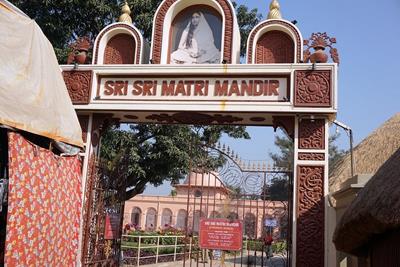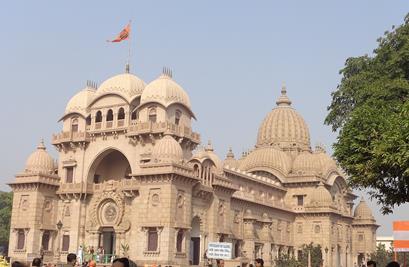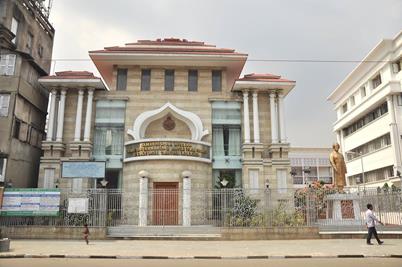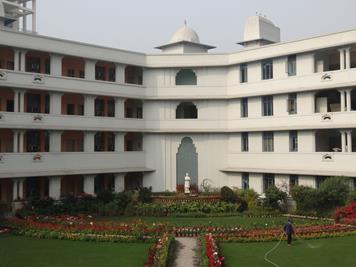Jata Mat Tata Path (যত মত তত পথ)
….. on the path of Sri Ramkrishna & Vivekananda (3-4 days)

Joyrambati is a small town in the Purba Bardhaman district of West Bengal, India. It is known for being the birthplace of Sarada Devi, the spiritual consort of Ramakrishna Paramahamsa. Joyrambati is a significant pilgrimage site for followers of the Ramakrishna Mission. Our itinerary in Joyrambati
-
- Matri Mandir (Mother’s Temple): In this enchanting temple, a vibrant white marble sculpture of the Holy Mother sits in the tranquil posture of ‘Dhyana Mudra.’ Swami Saradananda, with deep reverence, consecrated this sacred temple to the Holy Mother on the auspicious day of Akshaya Tritiya, precisely on the 19th of April, 1923. The temple is meticulously positioned at the very birthplace of the revered Sarada Devi.The temple holds profound significance as it stands on the hallowed ground where Shri Shri Maa’s father, Shri Ramchandra Mukhopadhyaya, had his original dwelling. Additionally, it marks the divine union between Shri Ramakrishna Paramhansa Dev and Shri Shri Maa, as their celestial marriage was solemnized at this very location.Every day, the Holy Mother is venerated within the temple’s sacred walls, with devout rituals and the offering of appropriate ‘Bhog.’ This spiritual haven stands as a testament to the enduring connection between the earthly and the divine, inviting pilgrims and devotees to experience the divine aura surrounding the Holy Mother’s abode.

- Puratan-Bari (Old House) & Nutan-Bari (New House): Maa Sarada resided in the Puratan Bari, the old house, from the year 1863 to 1915. Within the sacred confines of this dwelling, the Holy Mother bestowed blessings upon numerous aspirants, guiding them towards Brahmacharya, initiation, and Sannyasa. It served as a spiritual haven where seekers found solace under Maa Sarada’s divine grace.In addition to her spiritual teachings, Maa Sarada initiated the worship of Goddess Jagaddhatri within these walls, infusing the space with a profound sense of devotion. The Puratan Bari became a sanctuary for both spiritual seekers and the divine worship of the goddess.On the western side of ‘Punyo Pukur,’ a blessed tank frequented by Maa Sarada, Swami Saradananda selected a piece of land. This location, named so due to its regular use by the Holy Mother, became the foundation for a new dwelling place. Recognizing the growing number of devotees seeking refuge, a separate house known as Nutan-Bari was erected in 1915-16. This structure not only provided enhanced accommodation but also became a center for the expanding community of devotees drawn to the teachings and presence of the Holy Mother. The Nutan-Bari thus stands as a testament to the enduring spiritual legacy and the compassionate
- Amodar Ghat & Mayer Ghat: Amodar, the sacred rivulet, holds a special place as it was frequented by the Holy Mother for bathing alongside Golap Ma, Yogin Ma, and other devoted women. Maa lovingly referred to the Amodar as the Ganga, acknowledging its sanctity. The banks of the rivulet witnessed moments of serenity as Maa immersed herself in the profound practice of reading the Chandi, Gita, and engaging in meditation.Today, a thoughtfully constructed bathing ghat stands at the very spot where Shri Shri Maa used to partake in her cleansing rituals. This man-made ghat preserves the sanctity of the place where the Holy Mother once sought spiritual rejuvenation.Mayer Ghat, conveniently located near the temple, serves as a bus stop and rests on the banks of ‘Mayer Dighi.’ This is the very place where Mother, in her girlhood, used to come to cut grasses. The significance of Mayer Ghat extends beyond its role as a bus stop, as it echoes with the echoes of the Holy Mother’s early life and simple, grounding activities. It stands as a living testament to the sacred connection between Shri Shri Maa and the natural surroundings that enriched her spiritual journey.
- Shri Shri Singhabahini Temple: he Holy Mother, in her devotion, worshipped Maa Singhabahini along with her divine companions, Shri Mahamaya and Chandi. According to Shri Shri Maa and devoted followers, the presence of these revered goddesses is not merely symbolic but a living reality. The temple resonates with a historical wave, carrying with it a profound spiritual sensation that envelops all who enter.Within the sacred walls, the worship of Maa Singhabahini takes on a vibrant and palpable form, creating an atmosphere where the divine and the historical converge. Devotees can tangibly feel the spiritual energy that has been nurtured over time, connecting the present with the timeless devotion of the Holy Mother. The temple, therefore, stands not only as a place of worship but as a living testament to the enduring spiritual legacy and the divine energy that continues to inspire and uplift all who seek solace within its hallowed premises.
- Shihar: Shihar village, situated 3 km from Joyrambati, holds a significant historical connection. It was the residence of Shri Hridayram Mukhopadhyaya, the beloved nephew of Shri Shri Thakur (an affectionate term for Shri Ramakrishna). Notably, a precious manuscript of Shri Chandi, authored by Shri Ramakrishna himself, is diligently preserved in this village to this day.The village of Shihar, with its close ties to Shri Shri Thakur’s family, becomes a place of reverence for those seeking insights into the spiritual legacy of Shri Ramakrishna. The preserved manuscript adds to the cultural and historical richness of the region, offering a glimpse into the profound teachings and spiritual contributions of Shri Ramakrishna. Shihar village, thus, becomes not only a geographical landmark but a repository of invaluable spiritual heritage.
- Birthplace of Sri Ramakrishna: This area encompasses the humble hut where Sri Ramakrishna spent his childhood, a dedicated temple in his honor, and a Shiva temple known as Jugider Shib Mondir (যুগীদের শিব মন্দির). Positioned facing east, the Shiva temple is adorned with intricate terracotta works on its walls. It is believed that Sri Ramakrishna frequented this temple, engaging in the profound practice of reading Hindu scriptures.The simple yet spiritually significant hut, the temple dedicated to Sri Ramakrishna, and the ornate Shiva temple collectively form a sacred landscape that encapsulates the spiritual essence of this revered figure’s early years. The terracotta embellishments on the Shiva temple not only add to its aesthetic appeal but also serve as a testament to the cultural and historical richness of the region. This area stands as a living testament to the spiritual practices and cultural heritage associated with Sri Ramakrishna.
- Gar Mandaran (গড় মান্দারণ):A renowned destination for picnics, this area boasts a historic fort with a fascinating past. Originally under the dominion of Gajapati Kapilendra Deva from Odisha, the fort later came under the jurisdiction of Bengal after a historical transition. Notably, the site is also home to the tomb of the valiant warrior, Shah Ismail Ghazi.Nestled within this picturesque landscape is the notable Gar Mandaran, attracting visitors with its combination of natural beauty and historical significance. The fort stands as a silent witness to the shifting tides of history, reflecting the complex interplay of regional powers. Additionally, the tomb of Shah Ismail Ghazi adds a layer of cultural richness, commemorating the bravery and contributions of a revered warrior.
For those seeking both historical insights and a tranquil escape, this destination offers a blend of natural allure and historical intrigue. Gar Mandaran emerges not only as a popular picnic spot but as a gateway to a bygone era, inviting exploration and contemplation amid its scenic surroundings. - Raghubir Temple (রঘুবীর মন্দির Rôghubīr Môndir): Satberia: This laterite temple, once the property of the Rai family from Satberia, holds historical significance. It was within the sacred confines of this temple that Khudiram Chattopadhyay, the father of Sri Ramakrishna, dutifully performed priestly duties. This period coincided with the time when Ramananda Rai served as the zamindar (landlord) of Satberia.The temple, steeped in both architectural and familial history, serves as a tangible link to the past. It stands as a testament to the spiritual practices of Khudiram Chattopadhyay and his connection to the Rai family during the era when Ramananda Rai held sway as the zamindar. The echoes of priestly rituals performed within its walls resonate with the religious and cultural fabric of the region, connecting generations and enriching the historical tapestry of Satberia.
The Dakshineswar Kali Temple, also known as Dakshineswar Kalibari, is a Hindu navaratna temple located in Dakshineswar, Kolkata, West Bengal, India. Positioned on the eastern bank of the Hooghly River, the temple is dedicated to Bhavatarini, a manifestation of Parashakti Adya Kali, also known as Adishakti Kalika. Constructed in 1855 by Rani Rashmoni, a revered Zamindar, philanthropist, and devotee of Kali Maa, the temple holds significant historical and spiritual importance.
The architectural inspiration for the main temple stems from the Navaratna style Radhakanta temple in Tollygunge, built by Babu Ramnath Mondal of the Bawali Raj family. The temple complex, in addition to the nine-spired main temple, encompasses a spacious courtyard with surrounding rooms along the boundary walls. Along the riverfront, there are twelve shrines dedicated to Shiva, the consort of Kali, a temple devoted to Radha–Krishna, a bathing ghat on the river, and a shrine in honor of Rani Rashmoni.
Notably, the ‘Nahabat,’ located in the northwestern corner just beyond the last of the Shiva temples, holds special significance as the place where Ramakrishna and Maa Sarada spent a substantial part of their lives. The Dakshineswar Kali Temple is renowned for its association with the mystics of 19th-century Bengal, Ramakrishna, and Ma Sarada Devi, adding an additional layer of spiritual depth to its cultural and historical prominence.
The architectural inspiration for the main temple stems from the Navaratna style Radhakanta temple in Tollygunge, built by Babu Ramnath Mondal of the Bawali Raj family. The temple complex, in addition to the nine-spired main temple, encompasses a spacious courtyard with surrounding rooms along the boundary walls. Along the riverfront, there are twelve shrines dedicated to Shiva, the consort of Kali, a temple devoted to Radha–Krishna, a bathing ghat on the river, and a shrine in honor of Rani Rashmoni.
Notably, the ‘Nahabat,’ located in the northwestern corner just beyond the last of the Shiva temples, holds special significance as the place where Ramakrishna and Maa Sarada spent a substantial part of their lives. The Dakshineswar Kali Temple is renowned for its association with the mystics of 19th-century Bengal, Ramakrishna, and Ma Sarada Devi, adding an additional layer of spiritual depth to its cultural and historical prominence.

Belur Math serves as the headquarters of the Ramakrishna Math and Ramakrishna Mission, institutions established by Swami Vivekananda, the principal disciple of Ramakrishna Paramahamsa. Nestled in Belur, West Bengal, India, on the western bank of the Hooghly River, this spiritual haven was founded in January 1897 by Swami Vivekananda upon his return to India from Colombo. With a dedicated group of disciples, he initiated the establishment of two centers—one at Belur and the other at Mayavati, Almora, in the Himalayas, known as the Advaita Ashrama.
At the heart of the Ramakrishna movement, Belur Math is a symbol of unity among religions. The temple, with its architecture blending Hindu, Islamic, Buddhist, and Christian art and motifs, stands as a testament to the inclusive philosophy of the movement. This unique fusion reflects the belief in the harmony of all religions and serves as an inspiring beacon for spiritual seekers.
In 2003, the Belur Math railway station was inaugurated, dedicated to the Belur Math Temple, facilitating access to this revered site. The temple complex not only embodies the spiritual legacy of Sri Ramakrishna and Swami Vivekananda but also stands as a symbol of syncretism, welcoming people of all backgrounds to experience the universal teachings of Vedanta.

At the heart of the Ramakrishna movement, Belur Math is a symbol of unity among religions. The temple, with its architecture blending Hindu, Islamic, Buddhist, and Christian art and motifs, stands as a testament to the inclusive philosophy of the movement. This unique fusion reflects the belief in the harmony of all religions and serves as an inspiring beacon for spiritual seekers.
In 2003, the Belur Math railway station was inaugurated, dedicated to the Belur Math Temple, facilitating access to this revered site. The temple complex not only embodies the spiritual legacy of Sri Ramakrishna and Swami Vivekananda but also stands as a symbol of syncretism, welcoming people of all backgrounds to experience the universal teachings of Vedanta.

Swami Vivekananda, born on the 12th of January 1863, hailed from an ancestral house located at 105 Vivekananda Road, where he spent his formative years. This house, steeped in history, holds a treasure trove of stories recounting the ingenious activities of the man himself.
Following Swami Vivekananda’s passing, the ancestral home became the center of a legal dispute between his mother and aunt. Remarkably, the legal battle concluded just days before his demise, with Vivekananda securing full legal rights over the property.
In 1962, recognizing the deteriorating state of the house, the Ramakrishna Mission undertook the responsibility of its restoration. The organization, dedicated to the principles of the saint Ramakrishna Paramahansa—Swami Vivekananda’s spiritual guide—transformed the ancestral home into a museum. This museum now stands as a testament to the life and teachings of Swami Vivekananda, preserving the legacy of the great philosopher and serving as a source of inspiration for generations to come. The transformation of the house into a museum by the Ramakrishna Mission honors the profound connection between Swami Vivekananda and his spiritual lineage.

Following Swami Vivekananda’s passing, the ancestral home became the center of a legal dispute between his mother and aunt. Remarkably, the legal battle concluded just days before his demise, with Vivekananda securing full legal rights over the property.
In 1962, recognizing the deteriorating state of the house, the Ramakrishna Mission undertook the responsibility of its restoration. The organization, dedicated to the principles of the saint Ramakrishna Paramahansa—Swami Vivekananda’s spiritual guide—transformed the ancestral home into a museum. This museum now stands as a testament to the life and teachings of Swami Vivekananda, preserving the legacy of the great philosopher and serving as a source of inspiration for generations to come. The transformation of the house into a museum by the Ramakrishna Mission honors the profound connection between Swami Vivekananda and his spiritual lineage.

The Ramakrishna Mission Institute of Culture (RMIC) in Kolkata, India, stands as a prominent branch of the Ramakrishna Mission, having been established on 29 January 1938 as part of the commemoration of Sri Ramakrishna’s Birth Centenary Celebrations. Since its inception, the institute has flourished, finding its current residence at the magnificent premises located at Gol Park in Kolkata.
Recognized globally for its philanthropic, educational, and cultural initiatives, the institute has become a beacon of enlightenment and enrichment. Guided by the philosophy of the unity of human life, RMIC is dedicated to fostering an awareness of the diverse cultures around the world. It actively promotes the importance of intercultural appreciation and understanding as essential components of a harmonious and interconnected global community.
Through its multifaceted activities, the Ramakrishna Mission Institute of Culture continues to serve as a catalyst for intellectual and cultural exchange, contributing to the broader mission of the Ramakrishna Mission in fostering spiritual and humanitarian values. The institute’s commitment to the promotion of cultural richness and intercultural harmony reflects the universal ideals championed by Sri Ramakrishna and the Ramakrishna Mission.

Recognized globally for its philanthropic, educational, and cultural initiatives, the institute has become a beacon of enlightenment and enrichment. Guided by the philosophy of the unity of human life, RMIC is dedicated to fostering an awareness of the diverse cultures around the world. It actively promotes the importance of intercultural appreciation and understanding as essential components of a harmonious and interconnected global community.
Through its multifaceted activities, the Ramakrishna Mission Institute of Culture continues to serve as a catalyst for intellectual and cultural exchange, contributing to the broader mission of the Ramakrishna Mission in fostering spiritual and humanitarian values. The institute’s commitment to the promotion of cultural richness and intercultural harmony reflects the universal ideals championed by Sri Ramakrishna and the Ramakrishna Mission.

